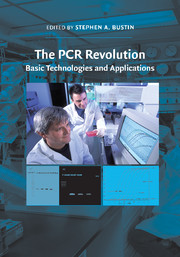Book contents
- Frontmatter
- Contents
- Contributors
- Foreword by Russell Higuchi
- Preface
- I BASIC TECHNOLOGIES
- 1 Real-time polymerase chain reaction
- 2 Thermostable enzymes used in polymerase chain reaction
- 3 Inventing molecular beacons
- 4 Rapid polymerase chain reaction and melting analysis
- 5 Polymerase chain reaction and fluorescence chemistries: deoxyribonucleic acid incarnate
- 6 Analysis of microribonucleic acid expression by quantitative real-time polymerase chain reaction
- 7 Miniaturized polymerase chain reaction for quantitative clinical diagnostics
- 8 The road from qualitative to quantitative assay: What is next?
- 9 Taking control of the polymerase chain reaction
- II APPLICATIONS
- Index
- Plate section
- References
2 - Thermostable enzymes used in polymerase chain reaction
Published online by Cambridge University Press: 25 January 2011
- Frontmatter
- Contents
- Contributors
- Foreword by Russell Higuchi
- Preface
- I BASIC TECHNOLOGIES
- 1 Real-time polymerase chain reaction
- 2 Thermostable enzymes used in polymerase chain reaction
- 3 Inventing molecular beacons
- 4 Rapid polymerase chain reaction and melting analysis
- 5 Polymerase chain reaction and fluorescence chemistries: deoxyribonucleic acid incarnate
- 6 Analysis of microribonucleic acid expression by quantitative real-time polymerase chain reaction
- 7 Miniaturized polymerase chain reaction for quantitative clinical diagnostics
- 8 The road from qualitative to quantitative assay: What is next?
- 9 Taking control of the polymerase chain reaction
- II APPLICATIONS
- Index
- Plate section
- References
Summary
THERMOSTABLE ENZYMES
Many living organisms have been found in most challenging environments that most of us would not believe possible. These microorganisms, known as extremophiles, are found in most extreme conditions of salinity, alkalinity, pressure, temperature, and so on. Most of these microorganisms have been identified as members of domain archae, which are ancient living organisms. The utilization of these organisms and their components (including enzymes) has been studied for a number of applications.
To live in these extreme conditions, those microorganisms have cellular components including biocatalysts – enzyme proteins – that are active in such conditions. Many studies have been carried out to enrich knowledge about such enzymes by identifying and characterizing them. Thermostable enzymes present in microorganisms living in extremely high temperatures are the most extensively studied enzymes and have a number of industrial applications.
Organisms that grow at high temperatures are called thermophiles when they grow optimally between 50°C and 80°C and hyperthermophiles when they grow optimally between 80°C and 110°C. There are some organisms that can grow under extremely hot conditions up to 113°C. Such enzymes are typically not active if the temperature is less than 40°C. These enzymes are also useful in understanding enzyme evolution and molecular mechanisms for thermal stability of proteins and identification of upper temperature limits for enzyme functions.
- Type
- Chapter
- Information
- The PCR RevolutionBasic Technologies and Applications, pp. 12 - 18Publisher: Cambridge University PressPrint publication year: 2009

